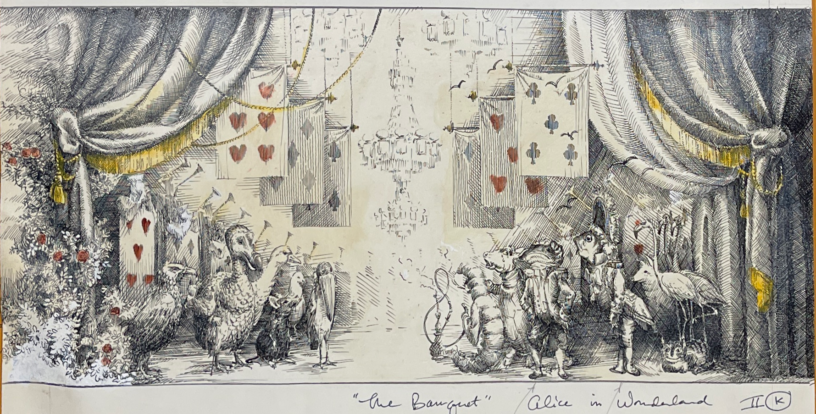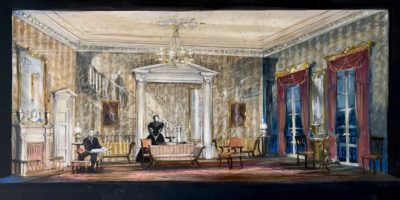It was a title, ‘Miss,’ much like a general’s rank one earned in the army, and therefore not to be ignored when one addressed her. Not for any especial pretense, just as a matter of fact of her station. Some friends, mostly female, called her ‘LeG’ but no one ever called her Eva. Word came back that a grip on her one and only film called her “Eva” and she went into a sulk and left the set. She was Miss LeGallienne.
She told me that she often had tea with Miss Barrymore on Thursday afternoons when she was a member of Miss Barrymore’s company. Yes, a ‘Miss’ (a female star ) could head a company … this was of a time when a director did not necessarily exist, and the hierarchy started with the actress who was presenting a ‘season.’ Eva LeGallienne had joined the company at 16 or so, a tiny teenager playing maids and small parts and learning from the example of the greats. John Barrymore had not yet begun to act and was the problematic ne’er-do-well brother of the head of the company. In the second season, at a Thursday tea, Miss Barrymore volunteered, “Eva, you have been with us in the company for two years, don’t you think you might call me ‘Ethel’ by now?” “Oh, Miss Barrymore, I could never do that!” the future ‘Miss’ Le Gallienne replied.
Having methodically read my way through the biography section of the Yale School of Drama’s library, the fifty years difference between us acknowledged, I was able to sit down and have a frank rap with Miss LeGalliennne about Jane Cowl (“a beautiful woman, but a limited actress”) or Josephine Hull. She went somewhat silent when I mentioned Joseph Schildkraut, opposite her as Liliom. I had read her autobiography “At 33” as a teenager seeking out theater books in my local library. I quizzed her about theater life on 14th Street and Union Square, learning that a cheap production would rehearse in an unheated ‘car barn,’ a converted stable. And that a ‘lady’ rehearsed in a suit and hat even when rehearsing Peter Pan. Once, stretched out on a tiny chaise, she observed to a friend that “He” hadn’t turned out so badly, that “He” hadn’t been such a bad actor once he put his mind to it, still problematic, but at least successful. I realized she had been discussing John Barrymore, as she had first known him before he was an actor. She was relieved that acting kept him from being such a burden to the revered Miss Barrymore. Later, I observed her on her little chaise wearing her little desert boots, recalling flying out over the audience in Peter Pan, not realizing that her little feet were twitching much like a dreaming dog’s as the sense memory enveloped her.
This woman was a legend, creating as an actor-manager and director, a repertory company in the midst of the depression. Starring before that in L’Aiglon, The Swan, Liliom, she was a huge, and tiny, shimmering star of the old school, but also a hard working modernist.
As she was to direct a revival of her Alice in Wonderland on Broadway and it was proposed that I design it, I was to be presented to her at her country house in Weston, Connecticut, for me to be approved. The door was opened and her tiny, ever present Yorkshire Terrier came out first in front of this tiny 84 year-old woman. I instinctively dropped to my knees to greet the terrier, then rose to meet Miss LeGallienne, who beamed with approval at my behavior. I was instantly ‘in.’ She took me to her little carpentry workshop where she had attempted a model of her design scheme, and we chatted about tools and building models, and knot-tying, and she was happy that I would complete her scheme—a hugely long double moving cyclorama. When told that my father was thrilled at my working with her (he was such a fan) she didn’t react, but when told my mother had taught me carpentry and knot tying, she opined that she would like to meet …my mother.
Bustling about in a long vest and trousers, her strength and her odd shyness were evident. She showed me her dress (by Worth) from The Swan and her Napoleonic uniform (tiny) from L’Aiglon. Discovering that I was soon to design The Seagull she opened up the piano bench to loan me pictures of The Moscow Art Theater’s production. When I asked how she got them, she said she was given them by the company. I asked why and she replied that she had gone to all 24 performances of their visit to New York and they rather adopted her as a mascot. Her hands were a bit deformed, a remnant of a notorious explosion of her furnace which burnt her badly, and she was quite intent, after quizzing me as to what I liked to drink, on having me knock back a glass of whisky. She enjoyed watching me drink, as she no longer could. She assumed I knew all about Laurette Taylor’s drinking and her famous story of redemption — giving up drink and triumphing in The Glass Menagerie — which Miss LeGallienne allowed not to be quite as simple as all that, having spent a tipsy afternoon with Miss Taylor at her Riverside Drive apartment. She clearly missed her drink.
Casting in the ‘modern’ way was a bit of a learning curve for Miss LeGallienne. In her day, the director—or actress manager—would know all the actors and cast accordingly. The idea of a casting director was antithetical to her. The frustrated and sidelined casting director did complain that Miss LeGallienne was intent on “casting every alkie and homo on Broadway.” Prophetic words, as it turned out, for indeed one of our beloved bachelor actors did fall off the toadstool drunk at a tech rehearsal. Miss LeGallienne also stood when any actor entered the audition room—out of respect. As we also had a live pig in the production, she stood for him as well as he entered to be approved.
The times had changed, for Miss LeGallienne was unperturbed when the production and performances didn’t soar in rehearsal. In her day, she explained, the accepted behavior was that one never displayed in the rehearsal hall the actual performance that the audience would see. One rehearsed to learn to coexist on stage together. She told me that before directors, the actress manager or star would take the lead responsibility in the rehearsal hall and all would arrange themselves sensibly about the stage in agreement. And star quality would only need appear when the paying audience arrived.
In this case, our quite good actors were left a bit at sea with little direction, and the only truly transcendent performance was by Miss LeGallienne herself as the White Queen. She hadn’t flown on a wire in thirty or forty years, and we only had twenty minutes of rehearsal before final dress rehearsal, so she climbed a ladder, beating away any hand that foolishly dared to assist her up, hooked on and took off to the stage, delivered her lines, flew again and landed, delivered her exit lines and flew offstage perfectly. At 84. As her companion, Anne Kaufman Schneider said, “Just when you want to kill her, she goes and does something like that!”
In front of an audience, she glowed, simple, clear and riveting . A star. See? Why can’t the others do the same?
Not the easiest to contend with in technical rehearsals, either, she was. Patricia Zipprodt, the costume designer and I came up with a style mantra for Alice in Wonderland, ‘Victorian Kabuki’ to guide us when we got lost. Black and white and only ‘playing-card colors’ were allowed, and great respect to recreating the Tenniel illustrations was required. Probably too much respect. Demanding the actors wear masks, Miss LeGallienne later ran down the aisles looking for scissors to cut the offending costume pieces when the actors couldn’t be heard or seen, saying that no one had any “gumption” anymore and that she would fix it. Miss Zipprodt dashing ahead, would remove offending costumes (quite fabulous) from her path. The costumes quite mysteriously would need ‘more painting’ and disappear overnight to Miss Zipprodt’s more easily protected workshop. Of course, Miss LeGallienne looked wonderful in her costume — she just couldn’t do anything wrong.
The scenic device of a two layered moving cyclorama was exceptionally well executed. Two 220 foot backdrops progressed from scene to scene seamlessly moving, and also revealing a puppet show for The Walrus and the Carpenter. But she resisted any more modern innovations, like a full-across winched deck or modern treadmill which would have made visual sense. When the show in performance wasn’t being embraced by the audience, she complained that the set wasn’t as good as the one at her Civic Repertory, but in fact, I think it was actually too good, in that it lacked the charm of the ‘dashed off’ original she had done so long before. We had to cut two wonderful scenic events—a shop and a carriage—since audiences were bored and no longer remembered the ‘beloved scenes’ of the Carroll works. In the ensuing 50 years, it turned out not everyone even knew the Carroll works that she and her early audiences had found so beguiling. We were now in the years of Star Wars. And boomers were introduced to Alice by Disney.
As the show progressed, Miss Le Gallienne’s supporters showed up: Kitty Carlisle, the Astors, the Rockefellers. They were eventually a political event in themselves—the power group in the balcony would be visited by Mayors and Governors and the rest of the power elite. And Miss Le Gallienne greeted all at the black tie opening flanked by Mrs. Astor and Miss Lillian Gish.
The show was actually a failure, and Miss LeGallienne expressed it in her tiredness. She didn’t really turn on us. She displayed a world-weary knowledge of theatrical failure as well as success. It was another aspect of her revealed.
She was also sad that an immediately funded Elizabeth Repertory Company was going to be inaugurated on Broadway—merely on the name of Elizabeth Taylor — not a theater star. Not a ‘Miss’ who had led armies —and suffered failures and great success and earned her title …
I never regretted a moment of it all, though it would have been a better career move to have avoided the show completely. I loved having soldiered next to Miss LeGallienne.
As Patricia Zipprodt said: “John, you’ve got your finger stuck in the electrical socket of theater history!”
___________________________________________________________________________________________________________
A very wise thing shared directly from Miss LeGallienne:
She said she had a ‘white’ quality in her acting, and she recognized that she had all the skills and knowledge to play a ‘red’ part like Lady Macbeth, but that she shouldn’t, and you wouldn’t want to see it. Great self-knowledge for all of us … Just because you are good at something doesn’t mean you are right for every project, even though you would be totally competent, you would always be ‘wrong’ if the role is ‘red’ and you are ‘white’. True for a designer, too. Discovered easily when you make the wrong decision. Hard to explain to a producer, though. Until the reviews come in, that is.
___________________________________________________________________________________________________________
I laughed when she complained she only got offered ‘old lady parts,’ after all, she was 84. But you know what she meant, and she had no interest in being sweet, feeble, ailing or dying onstage.
She was bored by eating — wished she could take a pill and just keep going. Food didn’t interest her, theater did. She liked to work, stubborn in her resolution.
I was working in the Lyceum Theater one day, and visiting the lobby recalled reading that she and the famous Shakespearean director Margaret Webster had a notorious fight in the lobby. This ‘Miss’ had ‘gumption,’ indeed.
Her picture is still in a place of honor at the Lyceum—who could replace her?









